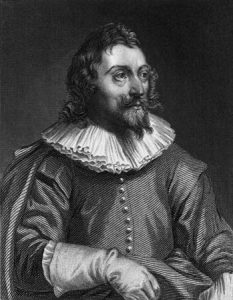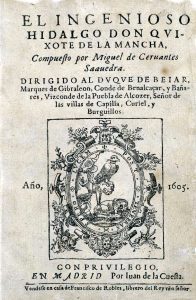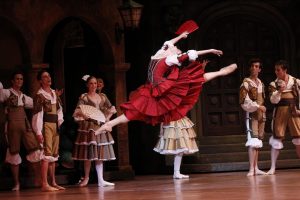
Pictured: Miguel de Cervantes, c. 1590. Archive Photos/Getty Images.
In Migel de Cervantes Saavedra’s Don Quixote, widely acknowledged to be the first modern novel, Sancho Panza says to Don Quixote, “Before long, there won’t be a winehouse, a tavern, or a barbershop where there’ll not be paintings commemorating the history of our exploits.” Indeed, the duo and their adventures have become so universally known that artists have rendered their likenesses again and again since the characters made their debut in 1605. Their author is one of the most renowned writers of all time.
Cervantes was born in 1547 as the fourth of seven children. Little is known of Cervantes’ formal education, although he did know Latin and read avidly. In his early life, Cervantes was a man of action and adventure. He joined the Spanish military at the age of 23, where he lost the use of his left hand fighting in the Battle of Lepanto. In 1575, Cervantes and his brother were kidnapped by pirates on their return voyage to Spain and sold into slavery in Algiers. Cervantes returned to Spain five years later after his family paid his ransom with the help of the nuns at the Convent of the Barefoot Trinitarians. To make ends meet in Spain, Cervantes worked as a commissary collecting taxes from rural communities. Frequent failures to correctly perform his duties resulted in charges of mismanagement, and Cervantes found himself in prison. There he began writing what would become Don Quixote.
“Before long, there won’t be a winehouse, a tavern, or a barbershop where there’ll not be paintings commemorating the history of our exploits.”
El Ingenioso Hidalgo don Quixote de la Mancha (The Ingenious Nobleman Don Quixote of La Mancha, as it is known in English) tells the tale of Alonso Quixano, a gentleman who has read too many books and fancies himself a knight errant. Quixano renames himself Don Quixote and aspires to restore the world of chivalry. After suiting himself in armor and fashioning a helmet from found wood and a metal hat, Quixote and his horse, Rocinante, set out for adventures where they fight (imaginary) giants, dragons, and wizards. Along the way, Quixote collects Sancho Panza, a simple peasant who agrees to be Quixote’s squire out of a growing curiosity and a desire for riches. Sancho blends the world of Quixote’s fantasy with reality and often acts as Quixote’s foil.

Pictured: The first edition (1605) inside cover of Don Quixote. Public domain, courtesy of Wikipedia.
Cervantes uses Quixote to parody and reference the popular Golden Age chivalric romances and picaresque novels that often paraded themselves as true history. Immediate widespread success of Quixote followed its publication in 1605. By August of that year, there had been two editions published in Madrid, two in Lisbon and one in Valencia, with additional publications in Brussels (1607), Madrid (1608), Milan (1610) and again in Brussels (1611). Even William Shakespeare was inspired by Cervantes to write the play Cardenio, which regrettably has not survived. Despite all of the success, authors at that time received no royalties for their creations and there were no copyright laws; consequently, Cervantes enjoyed little financial compensation for his masterpiece.
In the years following Don Quixote, Cervantes dedicated himself and his writings to a few different members of the Spanish nobility and increased his involvement in the religious and literary life of Madrid. This patronage allowed Cervantes to publish many of his other well-known writings including Journey to Parnassus, The Deceitful Marriage and an anthology of eight plays. He had already begun writing a second part to Don Quixote when another author, Fernandez de Avellaneda, published an unauthorized sequel of his own in 1614. It is said that the insulting publication of the False Quixote finally spurred Cervantes to finish the true second half. Less than a year later, Cervantes published the official conclusion to Don Quixote and cemented Avellaneda’s (otherwise unremarkable) fake in history.
In Part II, Don Quixote finds himself the subject of chivalric stories instead of the reader of them. His newfound fame leads to more misadventures and makes him the target of several cruel pranks. Cervantes even slips in references to and jabs at Avellaneda’s False Quixote. Quixote learns of the book and is wholly offended by it. Later, he meets a character from the False Quixote and insists he sign an affidavit asserting that the two have never met. The publication of Part II was equally well received and widely published. It is often considered the more rich and profound of the two parts.
Don Quixote finds himself the subject of chivalric stories instead of the reader of them. His newfound fame leads to more misadventures and makes him the target of several cruel pranks.
Cervantes died in 1616 from adult onset diabetes and was buried in an unmarked grave at the Convent of the Barefoot Trinitarians, where the nuns had previously raised money to pay his ransom and where he had prayed upon his return.
In the 400 years since his death, Cervantes has lived on through his characters and through countless authors who credit him as inspiration. William Faulkner said that he read Don Quixote once a year, as many others read the Bible. Mexican author Carlos Fuentes has called Cervantes the “founding father” of Latin American literature, a community in which Cervantes is often compared to Shakespeare. Though history distances us from Cervantes’ language, his characters and stories are universally known. The adventures of Don Quixote and his squire have been translated into more than 140 languages and are studied in classrooms worldwide. To this day, Don Quixote is the most published novel of all time, with over 500 million copies sold.
Contemporary language is now peppered with phrases and -isms first coined in Quixote. For example, de cuyo nombre no quiero acordarme (which translates to “whose name I do not want to remember”) is a commonly used Spanish expression. The word “quixotic” is used to described something exceedingly idealistic. The novel also popularized the idiom “The proof is in the pudding,” which was introduced by translator Pierre Antoine Motteux from Cervantes’ original: al freír de los huevos lo verá or “you will see when the eggs are fried.”
Cervantes’ characters have inspired many imitators and his impact on literature is global. French author Gustave Flaubert’s leading character Emma Bovary goes mad from imitating novels and Dostoyevsky’s Prince Myshkin is modeled after Don Quixote. Before the debut of Don Quixote and Sancho Panza, heroic teams were often equal in their bravery and talent.
Before the debut of Don Quixote and Sancho Panza, heroic teams were often equal in their bravery and talent. By contrast, Cervantes presented a contrasting duo—aspirational and grounded, tall and short, lean and stout.
Cervantes instead presented a contrasting duo—aspirational and grounded, tall and short, lean and stout, thereby providing the template for a popular trope in literature and film. Since then, comedic duos have come in contrasting pairs like Abbott and Costello, Dean Martin and Jerry Lewis, Gene Wilder and Richard Pryor, David Spade and Chris Farley and Sheriff Woody and Buzz Lightyear.
Quixote consistently finds himself incorporated into pieces of modern art. In the fall of 2016, a film festival in Washington D.C. featured international film projects inspired by Quixote, which included one film in English, one in Chinese, two in Spanish and one in Russian. There are currently seven different Don Quixote ballets. Perhaps the most famous adaptation of all is the musical Man of La Mancha which opened on Broadway on November 22, 1965 and ran for 2,328 performances. The production won for Best Musical, Best Composer and Lyricist (Mitch Leigh and Joe Darion respectively), Best Actor (Richard Kiley as Quixote), Best Direction of a Musical (Albert Marre) and Best Scenic Design (Howard Bay) at the 1966 Tony Awards. In 1972, the musical was adapted into a film starring Peter O’Toole in the titular role, which earned him a Golden Globe nomination for best actor.

Natalia Osipova in Don Quixote, The Australian Ballet 2013, photo © Jeff Busby
After reading the book, seeing one of the ballets and listening to the musical, fans of Don Quixote may want to attend the Cervantino International Festival in Guanajuato, Mexico, where artists all over the world come to create art inspired by the life and works of Miguel de Cervantes Saavedra. There, at the bottom of a rock cliff, the iconic figures of Don Quixote and Sancho Panza stand as testament to the enduring spirit of Quixotic delirium and the legacy of an internationally influential author.


No comments yet.